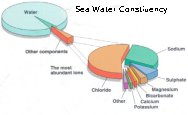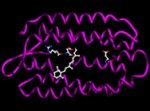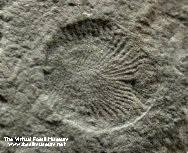Precambrian Time Paleobiology
Precambrian
Era Paleobiology
|
Forward to Paleozoic Era PaleobiologyAlso see: Geologic Time Clock Precambrian Fossils | ||||
Preface - the Sea and Genesis of Life
The
sea was the mother of all life beginning some 3.8 billion years ago, and remains
so today. The land-based animals each carry with them a miniature ocean, pulsing
in their cells and circulatory systems. All life, including human, could be viewed
as bags sea In all living cells - proteins answer for both form and function. Proteins are the active elements of cells that aid and control the chemical reactions that make the cell work. They receive signals from outside of the cell. They control the processes by which proteins are made from the instructions in the genes. They also form the scaffolding that gives cells their shape and as well as parts of the linkages that stick cells together into tissues and organs. A protein's shape determines its function, which, in turn, depends on its water-hating (hydrophobic) properties - to work proteins must be immersed in a miniature sea within the cell that does not greatly differ from the sea from whence it came. Life came from the sea, and the sea sustains life on earth, especially the many microbes that recycle the fundamental elements from which proteins are constructed (for example in the nitrogen cycle) Hadean Time (4500 to 3800 million years ago)
Archaean Time (3800 to 2500 million years ago)The
atmosphere that existed during Archean time would be toxic
to
most extant life on our planet. Also, rocks were just beginning
to form at the crust of the earth. It is believed that life
on
earth made its appearance in the seas during The origins of all modern cells occurred in deep time of the Archaean. Sequence comparisons of proteins thousands of different prokaryotes, together with assumptions of the slow mutation rate of prokaryotes lead to estimates that major classes of primitive microbes (chemotrophs and photosynthetic autotrophs) fused together more than 2.5 billion years ago in a process called endosymbiosis. This endosymbiosis, or symbiotic merging of two cells, enabled the evolution of a highly stable and successful organisms with the capacity to use energy from sunlight through photosynthesis. Perhaps no event is more important to the evolution of life of earth. Further evolution led to increasing diversity of photosynthetic organisms producing oxygen as a byproduct. The resulting oxygenation of Earth's atmosphere profoundly affected the evolution of life, leading to more complex organisms that consumed oxygen, which were the ancestors of all modern oxygen-breathing creatures including humans. Proterozoic
Era (2500 to 544 million years ago)
The Proterozoic, 2.5 bya to 544 million years ago (mya), realized events paramount to the further evolution of life, most notably the steady buildup of oxygen in the atmosphere. Stable continents formed. Bacteria and archaean microbes, some able to tolerate extremely hostile environments, became increasingly abundant. By about 1.8 bya, eukaryotic celled animals appear as fossils, These are the organisms that most people are most familiar with - all animals, plants, fungi, and protists which share fundamental characteristics such as cellular organization, biochemistry, and molecular biology. Cyanobacteria, photosynthetic Eubacteria that produce oxygen as a metabolism byproduct may have appeared of early as 3.5 billion years ago, but became common and widespread in the Proterozoic. The rapid build-up of oxygen in the atmosphere was primarily owing to their photosynthetic activity. Hence, cyanobacteria have been paramount in evolution and ecological change throughout earth's history. They have been attributed at least in part, because of the intense energy density of oxygen-burning aerobic metabolism of Eukaryotes, with the explosion of diversity in the late Precambrian into the Cambrian (the Cambrian Explosion). The other great contribution of the cyanobacteria is in the origin of plants. The chloroplast where plants make food is actually a cyanobacterium living within the plant's cells. Regardless
of whether the Eukaryotes with DNA-containing nucleus evolved
in the Arachaen or Proterozic, these ancestors of all plants,
animals and fungi are believed to have obtained their energy
complex
metabolism systems from endosymbiotic bacteria (known as the theory
of endosymbiosis). The cellular organelle mitochondria (and
associated mitachondrial DNA) of animals, the center of aerobic
energy production is believed evolved from aerobic Besides endosymbiotic-based metabolism, the other great evolutionary innovation of the Eukaryotes that occured in the Proterozoic was the ability to reproduce sexually, making genetic diversity possible, and as a consequence, greatly enhanced the ability to adapt to and survive environmental changes. Unlike prokaryotic bacteria that are identical clones, sex enabled favorable mutations to persist and amplify in a population's genome, and for multi-celled, soft-bodied marine organisms (metazoans) evolve.
| |||||
|
Fossil
Museum Navigation:
Home Geological Time Paleobiology Geological History Tree of Life Fossil Sites Fossils Evolution Fossil Record Museum Fossils | ||||||

 Any
consideration of the geological history of earth as it pertains
to the genesis and evolution of life, that is, to paleobiology,
must hold the sea as centric. Life began in the sea, and most
extant
Any
consideration of the geological history of earth as it pertains
to the genesis and evolution of life, that is, to paleobiology,
must hold the sea as centric. Life began in the sea, and most
extant 
 water
containing the same mineral constituency as the ocean together with a dynamic
dispersion of molecules that perform the biological processes that constitute
life.
water
containing the same mineral constituency as the ocean together with a dynamic
dispersion of molecules that perform the biological processes that constitute
life. 


 the
1970's. Domain Archaea include organisms that can exist, and
maybe
are the only organisms that can exist, in extremely hostile environments,
such as thermal vents and hypersaline water. However, not all
Archaeans are extremophiles, and, in fact, this domain is extremely
diverse, and only recently being studied using genomic and
proteomic
methods. The earliest primitive bacteria obtained energy through
chemosynthesis (ingestion of organic molecules). They produced
the oldest
fossils
that date to about 3500 mya, and are known as bacterial microfossils.
Discovered in the 1970s in western Australia, these earliest
fossils
express what appear to be chemical signs of delicate chains of
microbes that appear exactly like living blue-green algae (otherwise
known as cyanobacteria). For billions of years, these bacteria
formed extensive slimy carpets in shallow coastal waters, and
before the end of Achaean-time 2.5 bya had also formed a thin
crust on land. Known as
the
1970's. Domain Archaea include organisms that can exist, and
maybe
are the only organisms that can exist, in extremely hostile environments,
such as thermal vents and hypersaline water. However, not all
Archaeans are extremophiles, and, in fact, this domain is extremely
diverse, and only recently being studied using genomic and
proteomic
methods. The earliest primitive bacteria obtained energy through
chemosynthesis (ingestion of organic molecules). They produced
the oldest
fossils
that date to about 3500 mya, and are known as bacterial microfossils.
Discovered in the 1970s in western Australia, these earliest
fossils
express what appear to be chemical signs of delicate chains of
microbes that appear exactly like living blue-green algae (otherwise
known as cyanobacteria). For billions of years, these bacteria
formed extensive slimy carpets in shallow coastal waters, and
before the end of Achaean-time 2.5 bya had also formed a thin
crust on land. Known as 

